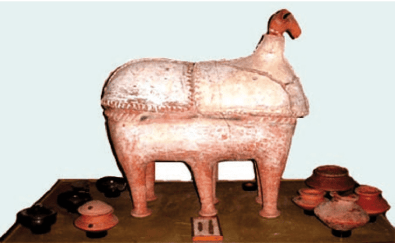Archaeological Significance of Andhra Pradesh
The contemporary region of Andhra Pradesh stands out as one of the most significant areas for archaeological cultures within the Indian subcontinent, showcasing an extraordinary tapestry of evidence that reflects uninterrupted human habitation spanning from the Lower Paleolithic era through to the early historical period. The region’s archaeological wealth is highlighted through stratigraphic excavations, where the early historical phase is preceded by rich Megalithic cultural layers, a characteristic feature found at nearly all excavation sites. In peninsular India, the Megalithic culture not only coincides with the Iron Age but also seamlessly extends into the early historical period. This latter phase is particularly notable for its literary and epigraphical sources, signifying the emergence of literate societies, sophisticated urban economies, and complex social structures.
Geographical Overview of Andhra Pradesh
Andhra Pradesh is geographically positioned at 16.51°N latitude and 80.52°E longitude. Spanning a total area of 162,970 square kilometers (62,920 square miles), it holds the distinction of being the 7th largest state in India. The state’s topography is marked by its highest elevation at Arma Konda, also referred to as Sitamma Konda, which towers at an impressive height of 1,680 meters (5,510 feet). Arma Konda is nestled in the northern segment of the Eastern Ghats within the Godavari River basin and is specifically situated in the Madugula Konda sub-range, located to the north of Paderu village in Alluri district, Andhra Pradesh.
Pre- History Era of Andhra Pradesh
The pre-historic era in the Andhra region is profoundly significant, with archaeological evidence indicating that human presence in the Krishna-Godavari valley dates back to approximately 300,000 B.C. The pioneering historian credited with the initial research in this region is Robert Bruce Foote, celebrated as the father of the Prehistoric Age in India. His remarkable contributions laid the foundation for future archaeological explorations. Other eminent historians who enriched the study of prehistoric Andhra include W. King, Henry Foote, Oldham, Burkit, and Aiyappan. Post-independence, notable advancements in archaeological research were led by H.D. Sankalia and his students from the prestigious Deccan College in Pune.
Paleolithic Phase
The Paleolithic phase in Andhra Pradesh encompasses the lower, middle, and upper Paleolithic cultures, with extensive evidence found throughout the region. Significant districts include Cuddapah, Chittoor, Nellore, Guntur, Krishna, and areas within present-day Telangana such as Adilabad, Medak, Karimnagar, Khammam, and Mahbubnagar. The predominant tools from this era include pebble tools, hand axes, cleavers, and discoids. A landmark site from this period is the Billa Surgam Caves in Bethamcherla mandal, Kurnool District, first discovered by the distinguished British geologist Robert Bruce Foote in 1892. These caves are notable for yielding a variety of animal carcasses, many of which were found headless, suggesting ritualistic practices.
Contributions of Robert Bruce Foote

Robert Bruce Foote’s contributions to Indian archaeology are unparalleled:
- Discovered the first conclusive Paleolithic stone tool, a hand axe, in India at Pallavaram, Chennai.
- In 1884, he discovered the 3.5 km long Belum Caves, the second-largest cave system in the Indian subcontinent.
- Conducted extensive research along the banks of the Penna River in Nellore district, unearthing 28 quartz tools.
- Discovered an ancient stone axe at Vaddemanu in Guntur district.
Contributions of Robert Bruce Foote
- Limestone: North of the Krishna River.
- Quartzite Stones: Northern Nellore District.
- Shingin Stones: Krishna Valley.
- Hematite Stone: Bellary and Cuddapah.
- Microlithic Industry: Giddalur.
Significant Paleolithic Sites Prominent Paleolithic sites across Andhra Pradesh include:
- Chittoor: Renigunta, Rallakaaluva, Veddullacheruvu, Gudimallam.
- Nellore: Venkatagiri, Racharla.
- Kadapa: Saraswathipalle, Thamballapalle, Sagileru.
- Anantapur: Guntakal, Visanakallu, Latthavaram, Velpulamadugu.
- Kurnool: Veerapuram, Sangameswaram, Dronachalam, Bethamcharla.
- Prakasam: Giddaluru, Dornala, Yerragondapalem.
- Guntur: Nagarjunakonda, Karampoodi, Chejarla, Naguleru.
- Krishna: Usthanavalli.
- Visakhapatnam: Varanadhi.

Mesolithic Age
The Microlithic period, also known as the Flake and Chipping period, is marked by the production of small stone tools.
Notable Sites
Notable sites for these tools in Andhra Pradesh include Giddaluru, Nagarjunakonda, and Kondapur, which reveal similarities to microlithic tools discovered near the Caspian Sea. The discovery and study of tools from this period in Andhra Pradesh are credited to Robert Bruce Foote.
Artistic Expressions
Artistic expressions from the Microlithic period are evident in the Borra Caves (Visakhapatnam) and Kethavaram Caves (Kurnool).
Borra Caves
The Borra Caves, located in the Anantagiri hills of Araku, are known for their fascinating speleothems, including irregular stalactites and stalagmites formed from karstic limestone. These caves, first documented in 1807 by William King George of the Geological Survey of India, highlight the natural artistry of geological formations and serve as a site of historical significance.
Artistic Representations in Mesolithic Age
Artistic representations in Andhra Pradesh date back to the Mesolithic Age, with deer being a recurring motif. One significant depiction from Pulicharla, Kurnool, shows a half-painted deer in front of a masked figure. Additional artistic elements, such as blurred paintings, sketches, and deer figurines, have been discovered in Kurnool, showcasing the creativity and symbolic expressions of the era.
Neolithic Age
Martimer Wheeler’s excavations at Brahmagiri provided the first evidence of stone axes associated with a pre-iron age farming culture, known as the stone-axe culture, which exists beneath the Megalithic levels.
Significant Neolithic Sites in Andhra
Significant Neolithic sites in the Andhra region include Nagarjunakonda, Utnur, Palavoy, Jami, Madhurwada, and Paddabankur.
Discovery of Neolithic Tools
In South India, the first Neolithic tool was discovered by Taylor in 1842 at Lingsugur in the Raichur district of Karnataka.
Noteworthy Archaeological Findings
Noteworthy archaeological findings include stone caves at Gandluru and agricultural fields located in Anantapur District (Palarayi, Lattavaram) and Kurnool District (Bethamcharla).
Neolithic Weapons and Tools
The weapons from this period were predominantly crafted from dolomite, with the era primarily beginning in Raichur. Additionally, sandstone axes were uncovered near Vaddamanu (Amaravathi), and a Neolithic tool implementation center was identified at Kadambapur.
Archaeological Significance
Mounds of burning soot were also found near Utnuru, highlighting the area’s archaeological significance. The concentration of Neolithic sites is notably higher in the Rayalaseema and Telangana regions, suggesting a potential migration pattern from Karnataka to Andhra.
Rock Paintings
Furthermore, rock paintings have been located at Regonda, Budigapalli, Mundamala, and Kethavaram, contributing to our understanding of Neolithic culture in the region.
Description of Rock Paintings
- Chintagunta: Painting of a man holding bows
- Velpulamadugu: Painting of humped bulls facing each other
- Thenagala: Painting of a dog and a deer in red color
Chalcolithic Age
The Chalcolithic Age in South India marks the beginning of the use of copper, with notable discoveries including copper artifacts found at Brahmagiri and Puducherry.
Chalcolithic Period in Andhra Pradesh
Archaeological Findings
In Andhra Pradesh, the Chalcolithic period is highlighted by significant archaeological findings.
Artistic and Utilitarian Advancements
At Pathapadu in the Kurnool district, painted pottery provides insights into the artistic and utilitarian advancements of this era.
Metallurgical Development
Copper tools discovered at Keesarapalli in the Krishna district underscore the development of metallurgy during this time.
Iron Age in Andhra Pradesh (1000 B.C – 900 B.C)
- Evidence at Alluru: Significant archaeological evidence from the Iron Age found at Alluru.
- Dr. Sankalia’s Observation: Rice was first harvested and consumed in Andhra Pradesh during this era.
Important Settlements
- Nagarjunakonda
- Jonnawada
- Boodigapalli
- Naidupalli
- Guntakal
Cultural Sites of the Iron Age
- Nagarjunakonda
- Budigapalli
- Naidupalli
- Jonnawada
- Guntakal
Rakshasa Gullu and Megalithic Culture
- Megalithic Characteristics: Large stone structures and unique burial practices.
- Artifacts:
- Black and red pottery discovered at Rakshasa Gullu.
- Similar artifacts found at Brahmagiri, Gudivada, Nagarjunakonda, and Pattipadu, reflecting widespread cultural influence.
Types of Rakshasa Gullu Structures (12 Types)
- Menhir: Standing stone; found in Revarala (Krishna district).
- Cist: Tomb-like structures found in most places in Andhra Pradesh except Visakhapatnam.
- Dolmen: Found in Krishna, Guntur, East Godavari, and West Godavari districts.
- Sarcophagus: Lamb-shaped coffin found in Sankhavaram (Kurnool district).

Notable Discoveries
- Eleswaram: A grave containing both male and female bodies in the same coffin.
Other Names for Rakshasa Gullu
- Kurambara Gullu: Chittoor district.
- Pandava Gullu: Kurnool and Kadapa districts.
- Morivara Gullu: Anantapur district.
